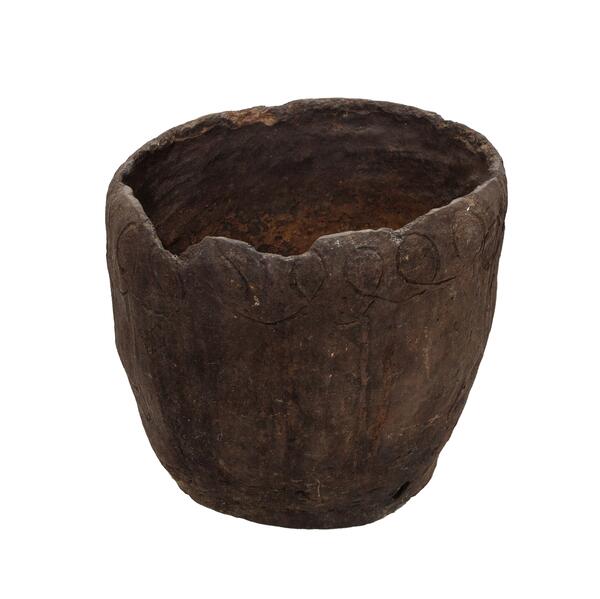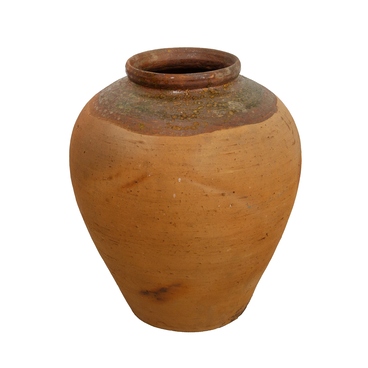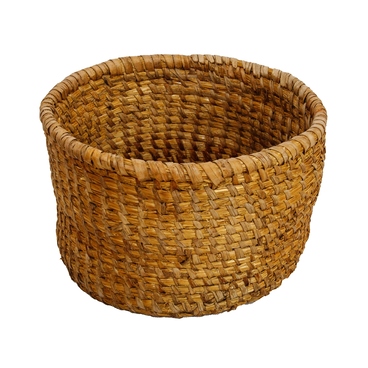A korchaga (earthenware pot) is a large clay pot or jug with a wide throat and two vertical handles. It was used to store various foods and beverages, such as home brew.
The earthenware pot, presented in the museum’s exhibition, is a pot of dark brown color, cylindrical in shape, slightly tapered downwards. The pot walls are unevenly smoothed. The upper uneven edge with chips is ornamented with a spiral line scratched on the clay. At the bottom of the pot, at a distance of 26 centimeters from each other, through holes with a diameter of 1 –1.2 centimeters are made to drain the finished drink.
Masters created similar dishes in the Saransk district villages of the Penza province (the territory of the Kochkurovsky district, the Mordovian ASSR), inhabited by the Mordovian-Erzya people: Kochkurovo, Novaya Pyrma, Tavla. Traditionally, only women extracted, prepared clay, molded and fired pots here.
The earthenware was mainly used for milk or home brew; its forms were not very diverse. Sometimes a simple ornament was applied to the walls with hands or improvised tools, for example with a stick.
A craftswoman could make about 10 pots in a working day. The pots took 1-2 months to dry, after which it could be fired. The firing was carried out in a home-made Russian oven. For a week, the pots were tempered in the lower part of the oven, when cooking food. After such preliminary preparation, they were fired: laid on the side on birch logs stacked in a “well” form. Eight medium-sized pots, or two large earthenware pots, were placed in the oven. Fire wood was set on fire. At first, the clay turned black from the smoke, then turned white from the heat, and finally became translucent red. So the craftswoman understood that the dishes were ready.
While the earthenware pots were being fired in the oven, people prepared a liquid for the scalding — the so-called “bread ovara”. For cooking it, the craftswomen diluted sediment, remaining after making malt kvass or rye flour with hot water. “Ovara” was poured into a trough and red-hot pots were immersed in it for 1-2 minutes, after which they were put on the ground. The pots created in this way became black and waterproof, since the “ovara” clogged all the pores of the clay.
Hand-sculpted crockery, as a result of such processing, turned out to be massive and heavy, but very durable: its service life ranged from 20 to 50 years.
The earthenware pot, presented in the museum’s exhibition, is a pot of dark brown color, cylindrical in shape, slightly tapered downwards. The pot walls are unevenly smoothed. The upper uneven edge with chips is ornamented with a spiral line scratched on the clay. At the bottom of the pot, at a distance of 26 centimeters from each other, through holes with a diameter of 1 –1.2 centimeters are made to drain the finished drink.
Masters created similar dishes in the Saransk district villages of the Penza province (the territory of the Kochkurovsky district, the Mordovian ASSR), inhabited by the Mordovian-Erzya people: Kochkurovo, Novaya Pyrma, Tavla. Traditionally, only women extracted, prepared clay, molded and fired pots here.
The earthenware was mainly used for milk or home brew; its forms were not very diverse. Sometimes a simple ornament was applied to the walls with hands or improvised tools, for example with a stick.
A craftswoman could make about 10 pots in a working day. The pots took 1-2 months to dry, after which it could be fired. The firing was carried out in a home-made Russian oven. For a week, the pots were tempered in the lower part of the oven, when cooking food. After such preliminary preparation, they were fired: laid on the side on birch logs stacked in a “well” form. Eight medium-sized pots, or two large earthenware pots, were placed in the oven. Fire wood was set on fire. At first, the clay turned black from the smoke, then turned white from the heat, and finally became translucent red. So the craftswoman understood that the dishes were ready.
While the earthenware pots were being fired in the oven, people prepared a liquid for the scalding — the so-called “bread ovara”. For cooking it, the craftswomen diluted sediment, remaining after making malt kvass or rye flour with hot water. “Ovara” was poured into a trough and red-hot pots were immersed in it for 1-2 minutes, after which they were put on the ground. The pots created in this way became black and waterproof, since the “ovara” clogged all the pores of the clay.
Hand-sculpted crockery, as a result of such processing, turned out to be massive and heavy, but very durable: its service life ranged from 20 to 50 years.



